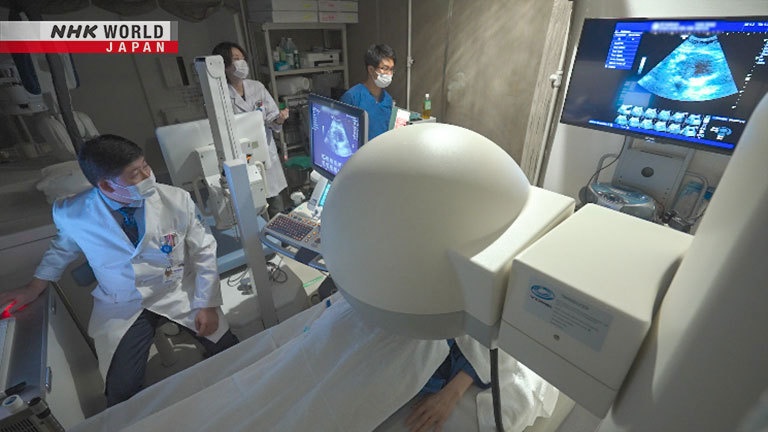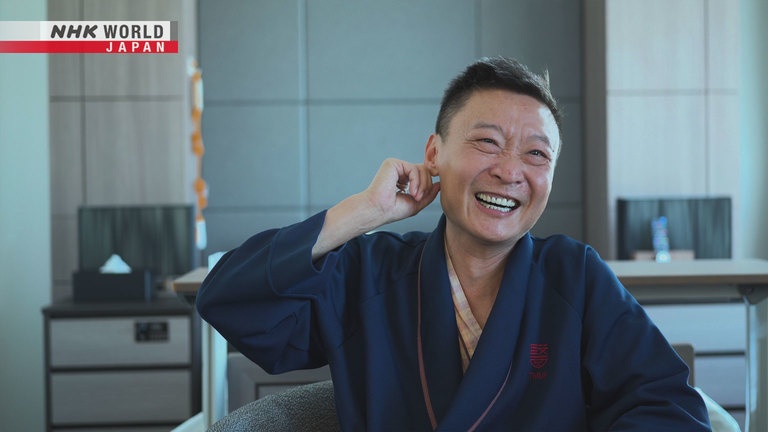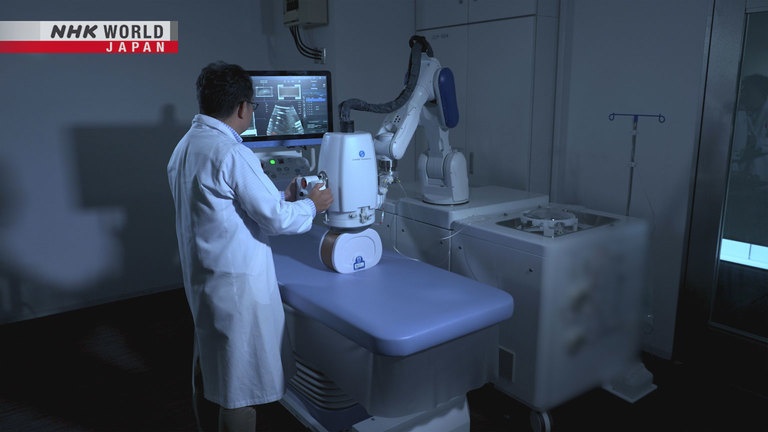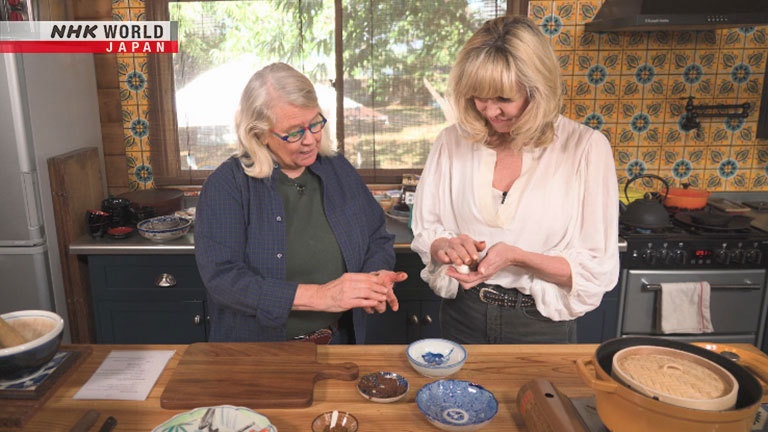Destroying Pancreatic Cancer With Ultrasound
Ultrasound is emerging as an effective treatment for pancreatic cancer. HIFU uses focused heat to target and destroy cancer cells, and there is minimal harm to the body. We report on its potential.




Transcript
Join us as we explore "Medical Frontiers."
We hear a variety of sounds in our daily lives.
Sound is a form of energy.
Sound waves of certain frequencies can cause objects to vibrate, and these vibrations reach our ears.
However, we can only hear a limited range of sounds.
Ultrasound is a type of sound that we can't hear, and it is used in medicine.
This technology is utilized in various areas, from generating images of babies to be and to cleaning precision instruments.
In Japan it's proving effective in the challenging field of pancreatic cancer treatment, potentially marking a new frontier in cancer therapy.
Tokyo Medical University Hospital actively uses ultrasound to treat pancreatic cancer.
In ultrasound treatment, patients lie face up and a cone-shaped device is placed on the abdomen.
Doctors use ultrasonography to monitor the area in real time, while applying ultrasound to cancer cells.
Using intense heat, ultrasound can destroy only targeted cancer cells.
This treatment lasts 30 to 40 minutes, and does not involve incisions.
You're done.
To understand how ultrasound works inside the human body,
we tested its effects on chicken meat.
The experiment was conducted by Tohoku University's Yoshizawa Shin, who has been studying medical applications of ultrasound.
It was done in water, where ultrasound behaves like it does in soft tissue.
Ultrasound reaches its peak intensity at its focal point.
It was aimed at a specific spot inside the chicken.
Ultrasound passes through the inner layers
before focusing on a specific point.
I'll start.
This image shows the emission of ultrasound used in treatment.
The red spots indicate areas where the temperature has risen, due to exposure to strong energy.
Ultrasound was emitted in the direction of the arrow.
No changes can be seen on the surface.
But when we slice the chicken...
the spot where heat was applied has turned white.
Beyond that, there are no changes.
This indicates that therapeutic ultrasound can heat specific inner tissue at pinpoint accuracy, without affecting the surrounding tissue.
It's like frictional heat.
Motion between objects due to ultrasound
converts part of energy from waves into heat.
In radiotherapy, radiation damages not only cancer cells, but also the surrounding normal cells, as it passes through them.
On the other hand, ultrasound, while passing through tissue, affects only the targeted cancer region.
It can generate enough heat to kill cells only where its energy is focused.
It's used in a treatment technique called High-Intensity Focused Ultrasound, or HIFU.
Sofuni Atsushi is a leading expert in HIFU therapy for pancreatic cancer.
He has treated over 500 patients using this method.
Professor Sofuni, thank you so much for your time today.
So in terms of HIFU therapy itself, what are the advantages of HIFU compared to regular treatments for pancreatic cancer?
With HIFU, the target area's temperature
rises to 60℃ right away, then eventually to 100℃.
Cancer cells typically coagulate and die
at 55℃ within 15 seconds.
Just 7 millimeters away from the target area,
the temperature instantly drops below 60℃.
It's an innovative therapy as it
doesn't affect the surrounding organs.
It doesn't require anesthesia nor
painkillers, and it's minimally invasive.
Pancreatic cancer is extremely difficult to treat.
About 70 percent of cases are detected when the cancer has advanced too far for surgical removal.
The three-year survival rate for these cases is around 3.2 percent.
Even if surgery is an option, the cancer returns within two years in about 60 percent of patients.
Ultimately, it recurs in about 80 percent.
Since 2008, Sofuni has been conducting clinical studies combining HIFU and chemotherapy, for patients with inoperable pancreatic cancer.
The median survival time after treatment of patients who underwent only chemotherapy was 288 days.
But for those who had a combination of HIFU and chemotherapy, it was 648 days.
The addition of HIFU helped them to live longer.
So Professor, why does HIFU, how does that boost the effectiveness of chemotherapy?
Pancreatic cancer is highly likely to recur.
Chemotherapy is a standard treatment for it,
and it is always the first step.
Chemotherapy can support HIFU
by shrinking the tumor in advance.
Sofuni also believes that once HIFU has destroyed a tumor, it can easily be penetrated by anti-cancer drugs.
In other words, combining HIFU with chemotherapy may create synergistic effects.
This patient is from China.
Currently, about 20 percent of patients undergoing HIFU therapy by Sofuni come from abroad.
He developed pancreatic cancer in 2020, when he was in his late 40s.
The tumor was already 4.5 centimeters in size, and had become intertwined with blood vessels, making it inoperable.
At the time, I wouldn't say that I felt afraid,
but I couldn't accept that my life was ending.
To be honest, it was the first time
that I felt very close to death.
A hospital in China referred him to this facility, and he traveled to Japan in the spring of 2021.
He received his first HIFU session in April that year.
I would fall asleep during each session.
I felt normal. There was almost no pain.
I just lay down and felt the pressure from
the device. The treatment went smoothly.
HIFU therapy shrank his tumor, untangling it from the blood vessels, and allowing for surgical removal of the remaining part.
The cancer later recurred in the surrounding tissue.
He has had a total of five HIFU sessions, and is continuing with treatment.
One month has passed since his last session, and there are no more signs of recurrence.
How are you feeling?
Good.
You've been doing great so far.
We'll continue with chemotherapy.
Do you realize it's already been 3 years
since I got cancer? Is this a miracle?
Your HIFU treatment went extremely well.
The cancer is now hardly detectable.
But pancreatic cancer sometimes
returns, so let's continue.
OK.
And in terms of your patient, you had a Chinese patient, can you explain what wouldn't have been achieved without HIFU?
It was a localized, advanced cancer. We believed
that it wasn't treatable with chemotherapy alone.
We therefore gave him HIFU and chemotherapy.
The tumor shrank, making surgery possible.
I believe this wouldn't have been
possible with just chemotherapy.
So why did the Chinese patient, why did he end up undergoing five separate HIFU treatments?
His tumor returned after surgery, which is
often the case with pancreatic cancer.
We did 3 additional HIFU sessions
on the recurrent tumor.
As long as a tumor is visible with ultrasound,
multiple HIFU sessions are possible without
causing harm to the surrounding organs.
That's one advantage of HIFU.
And Professor, are there any cases where HIFU is less effective for certain patients or certain conditions?
Unfortunately, HIFU cannot
entirely eliminate cancer.
Advanced metastatic tumors
are especially difficult.
In addition, ultrasound can only reach about
10 centimeters below the skin's surface.
This means cancers in the tail of the pancreas,
near the spleen, are untreatable with HIFU.
The patient who had five HIFU sessions is now gradually reducing his intake of anti-cancer medication.
His health has improved, and he's able to go on trips with his family.
My condition is good.
Everybody says I seem better than before.
They all tell me that when they see me.
I go travelling, and I enjoy good food.
Only a handful of hospitals globally offer HIFU therapy for pancreatic cancer in the same manner as Sofuni.
The approach has captured the attention of researchers worldwide.
Doctors from Stanford University in the United States visited Japan in October 2023 to see the procedure in person.
They were intrigued by the various synergistic effects produced when combining HIFU with other therapies.
HIFU has a unique benefit.
It's used as a mode to decrease the tumor and also enhance drug delivery to the tumor and potentially enhance the immune response;
so that we can battle what we call metastasis.
So I think that that's one of the most promising aspects of focused ultrasound for treatment of tumors.
However, they point out that HIFU can only be performed by a limited number of experts.
At this stage it really takes somebody who's an expert with some of these tools, to be able to do a good job with the treatment.
There are only a few places in the States that have experience using this technology.
Dr. Sofuni is unique in the amount of experience that he has with this technology.
Like everything else, people that have experience, they make things look easy.
But for someone who is new, it's going to take some time to develop that same knowledge, that same experience, that same confidence.
There are two problems with the device currently used for HIFU.
First, interference between the ultrasound used to monitor the procedure and the ultrasound used for treatment leads to distorted images.
This makes it difficult to accurately monitor the treatment area.
Second, the ultrasound must be manually focused on the tumor.
This is very difficult without extensive experience.
In response to these challenges, a startup formed by several universities has developed a next-generation HIFU treatment system.
Tohoku University Professor Yoshizawa oversees technological development, and has devised solutions for these issues.
This image, taken by a high-speed camera, shows the moment ultrasound reaches its focal point.
High-Intensity Focused Ultrasound creates air bubbles at its focal point.
This phenomenon is called cavitation.
It happens when water is churned, such as by a ship's propeller.
The new system uses ultrasound at a higher intensity than the conventional one to generate bubbles at the focal point.
Because the device produces cavitation bubbles,
anyone can tell where the ultrasound is focused.
The new version is also equipped with a robotic arm, which helps with the accurate positioning of the HIFU focus.
This allows even less-experienced doctors to conduct HIFU treatment.
The device's effectiveness and safety are being tested in clinical studies launched in 2023.
I am hopeful for the progress of the new device's
development and the clinical studies.
I believe HIFU will emerge as the fourth
treatment option for pancreatic cancer,
following surgery, radiotherapy and chemotherapy.
Professor Sofuni, thank you so much for your time.
Thank you so much.
Miso is a traditional Japanese fermented food.
It is attracting attention as a superfood with powerful antioxidant properties, that can boost immunity.
There are different kinds of miso, made from ingredients such as soybeans, rice and barley.
Today, Nancy Singleton Hachisu from California, who now lives in Japan, will share some recipes that use miso.
- Hi!
- Great to see you!
Since marrying a Japanese farmer 35 years ago, Nancy has been exploring the breadth of Japanese cuisine.
- So, Nancy, thank you so much.
- Thank You!
- Pleasure to have you on the program. Very exciting!
- Thank you much.
The first dish is miso-cured eggs.
We're going to put miso on these two eggs, and I've already done some.
- So, let's start with these.
- OK.
Prepare barley miso and eggs that have been boiled for nine minutes.
So, you just grab some miso.
And we're going to spread it around like that.
OK, great. So we grab the egg first or the miso first?
- Whichever you like.
- All right.
Don't spread it on your hand too much.
But the one point is you can't do it on cold eggs.
- They have to dry, dry, dry.
- OK.
Otherwise, the miso just doesn't stick.
Let the miso-enclosed eggs cure in the refrigerator for four hours.
We're going to take the miso off.
Then the miso can be reused for one more time pickling, or like for miso soup or something.
- Otherwise, it'd be such a waste to throw out.
- Yes.
So when you take it off, is there a technique? Or just wipe it off?
Yeah, just like that.
Slice the eggs in half lengthwise, and arrange them on a plate.
Sprinkle "shichimi," seven-spice powder, on them, and serve.
- I mean, that's such a super quick, simple, easy recipe for anyone to do.
- Totally, yeah.
So, "itadakimasu."
Oh, wow! It's incredible how much this is four hours only in miso.
The miso is a big point, because it just sort of transforms it to being something special.
And of course, the seven spices.
Yeah, the miso is really special.
Miso and Seven Spice are like a matchmade.
- Absolutely delicious.
- Good. Thank you.
- All right. Shall we go for the next one?
- Absolutely.
The second dish is steamed Japanese daikon raddish with miso.
It's steamed daikon, or could be simmered daikon, usually in "dashi," and then dashi is a "kombu."
- I don't know if you can see, but there's the kombu on the bottom.
- Yeah, I can.
Place kombu seaweed at the bottom of a steaming basket.
Peel the daikon, cut it into 4-centimeter-thick rounds, bevel the edges, and put it on the kombu.
- We're gonna steam it for 20-25 minutes.
- Let's put the top on. Get it going quicker.
- OK, great.
Steam until the center of the daikon can be easily pierced with a bamboo skewer.
Put kombu dashi stock and the other ingredients into a saucepan, add the daikon, and let it steep for about 10 minutes.
Now prepare a miso sauce to put on the daikon.
So then next, what I've got here, I've got some sugar and then some "mirin."
And to this, we're going to add miso.
Is that the same miso that we used before with the eggs?
No, this is soybean miso.
Stir all the ingredients over medium heat.
So, we always come in and mess things up...
So, it's not very much...
You're melting the sugar, and then also... you don't want to burn the miso.
So, what you're trying to do is get it glossy.
Looks like a gorgeous, rich chocolate, like a chocolate icing.
For more flavor, add squeezed juice from grated ginger and the liquid used to cook the daikon, then mix.
- So people who can only get hold of one type of miso, can we just use one type of miso in this, for example?
- Sure.
Spoon the miso sauce on the daikon to complete the dish.
Looks beautiful. Oh, my gosh.
I love the contrast with the white daikon and the miso.
So I think I'm gonna go for one bite.
That miso is so good.
I mean, daikon is always so incredibly juicy when it's steamed; I love the combination of... that richness of the miso.
Looks great.
The third dish is grated turnip miso soup.
There should not be lots of stuff inside the miso soup.
Prepare grated turnip.
- So in this miso, using grated turnip?
- Yes.
Which is kind of the first time I've heard of that, actually, in the miso soup.
It changes with the soup part to sort of like a warming kind of thing.
Prepare kombu dashi.
- I soaked the kombu last night.
- Yes, yes.
- And then slowly, like 40 minutes, just on very, very, very low, just to bring out the lovely kombu flavor.
- OK.
Put the turnip into bowls, while the dashi is heating.
- Tofu... in.
- Yes.
The tofu looks like it's getting happy.
So how do you tell if it's getting happy?
Well, it's moving around, it's wiggling.
- It's dancing, it's doing a tofu dance.
- There you go, ok!
Add a little dashi to the miso in a small bowl to loosen.
Make sure you turn off the heat before you add the loosened miso.
Miso loses its flavor when it's boiled.
Pour the miso soup over the turnip in the bowls.
Garnish with a sprinkling of black sesame seeds and yuzu zest.
Like you put things in from above, like 30 centimeters.
- It smells amazing. Absolutely beautiful.
- Good, all right.
- Ok, shall we taste it?
- This is gorgeous!
So you're in at the farmhouse. So then, what do I do?
Wow! It's absolutely... it's incredibly warming, perfect for this season.
Miso soup, it's such an easy way, I think, to enjoy the amazing benefits of fermentation.
First of all, one very big point is that you don't heat the miso.
And so that keeps the enzymes all and the "koji."
Koji is the fermentation spore that's put on the brown rice or the soybean.
You kill the enzymes in the koji when you heat it too much.
- Miso is almost like a natural medicine.
- Oh, yeah, for sure. Yeah.
So it's just like kind of the perfect dish.
So, Erica, we finished three miso dishes: which one was your favorite?
- I have to say, honestly, the miso soup was one of the best I've ever had.
- OK, that's great.
- Fabulous. Thank you.
- Thank You! Thank you for coming.